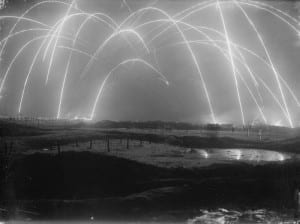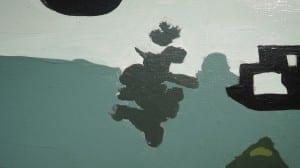Military history mural at Small Arms Ltd. building in Mississauga
I much enjoy viewing the mural, related to military history, located at Dixie Road and Lakeshore Road East in Mississauga. This is an impressive and engaging work of art, presented in what I like to characterize as an open-air art gallery.
This post focuses on some of the details featured in the mural.
A good time of day to see the mural is in the early afternoon, around 3:00 pm and later, when the sun is directed toward the surface of the mural. That’s in the summer. In the winter you won’t see sunlight hitting the mural, except in cases where the mural is leaning way over after an onslaught of high winds has caused it to lean over, until it comes to rest on the edge of a sign that is located a very short distance away from it.
I like to view the mural in the afternoon when there is glare visible on the surface. In the photos at this post, some of the glare is visible in the upper right hand corner of each image.
Gestural qualities
If you click on the image, and click again, you can observe the brushwork, which has a strong gestural quality that I find appealing.
The beauty of the mural, among its other qualities, is that it’s presented in an informal, open-air gallery environment.
The mural addresses themes of relevance to the Small Arms Ltd. building located just behind the steel fence on which the murals are mounted.
The artwork also addresses themes of relevance to the Lakeview Waterfront Connection and Inspiration Lakeview, the Hanlan Water Project, Canada’s First Aerodrome, the First and Second World Wars, and the First Nations history of the area.
Three plywood panels bolted to a steel fence
The mural is made up of three plywood panels, bolted to a new, temporary steel fence – reminiscent of barbed-wire fences still standing in the area – in front of the Small Arms building located a short distance to the south of the fence.
The images on the three-part panel are well planned and executed in a style that focuses on the body language of the subjects in the source photographs, upon which the images are based. The text and typography are also handled beautifully.
The level of detail in the imagery is kept to a minimum, as is the case with all of the key traffic communications and other signage in the surrounding area. The mural is an integral part of the visual experience of a person walking in south Etobicoke of Lakeview.
Much is left for the viewer to fill in, with regard to the content, yet the major themes are clearly communicated.
The colour scheme fits in beautifully with the surrounding streetscape and landscape.
World War 1 centenary
An Aug. 2, 2014 CBC article is entitled: “When Canada went to war: The story behind our involvement in WWI: Within weeks of declaration of war, Canada sent 33,000 soldiers to Europe.”
The article notes: “Canada’s decisive role in pivotal battles such as Vimy Ridge and Passchendaele helped the country gain international standing, but it came with a cost: over the duration of the war, 61,000 Canadian soldiers lost their lives.”
Impact of the war on Canada

Trench Warfare. Photo taken by an official British photographer during WWI, 1917. Source: History In Pictures @HistoryInPics
An Aug. 3, 2014 Toronto Star article is entitled: “World War 1 centenary: The war ‘blew a hole’ in our country: A conversation with historian J.L. Granatstein, City of Toronto chief curator Wayne Reeves and actor/director Paul Gross about the war’s impact.”
In the article, which I read with interest, J.L. Granatstein notes that the First World War was an “industrial, mechanized total war, with horrific weapons and gas, of a kind no one had ever seen before.”
Regarding these topics, an April 5, 2011 Deutsche Welle article is entitled: Everyday stories from WWI preserved in massive European archive.” The subhead reads: “With the 100th anniversary of the outbreak of World War I quickly approaching, a European project is digitally documenting personal memorabilia – before it is lost forever to time and indifference.”
An Aug. 7, 2014 Guardian article is entitled: “Enemies in life, comrades in death: A century to count the cost of war.” The subhead reads: “Generation, whose lives were blighted by a conflict that claimed some 17 million military and civilian lives, honoured.”
A Dec. 20, 2014 CBC article is entitled: “WWI Christmas Truce still remembered: No shot fired on Dec. 25, 1914, during spontaneous momentary truce.”
A Dec. 25, 2014 CBC article is entitled: “WWI soldiers’ files being digitized by Library and Archives Canada: Archives begins painstaking process of getting its most-requested items online.”
War of 1812
The outcome of the War of 1812 ensured that there was such a thing as a Canadian military role in the First and Second World Wars. A key aim on the American side, at the beginning of the War of 1812, was the conquest of Canada. Two key 1813 battles – the Battle of Chateauguay and the Battle of Crysler’s Farm – ensured that the plans for conquest of Canada were put aside. Without these prior details having been addressed, Canada would not have come into being as a nation-state as it did in 1867.
The War of 1812 assisted in the creation of a sense of national identity for Canada as it did for the United States.
For their own respective reasons, as I understand, both sides were convinced that they had won the war.
From the Canadian perspective, the fact that Upper and Lower Canada remained independent, when the war was over, was a sign of success.
From the American perspective, the fact that the United States had managed to avoid defeat by the supreme world power of the era, namely the British empire, was a sign of success.
The Battle of Crysler’s Farm is best understood in the context of the War of 1812 as a whole. An excellent overview of the context is provided by 1812: A Guide to the War of 1812 and Its Legacy (2013). It’s an impressive and readable study, with great illustrations, photographs, and maps. Among the contributors is Terry Copp, whose work I follow with interest.
A useful resource, which in turn helps to place the War of 1812 into a wider context, is Waterloo: June 18, 1815: The Battle for Modern Europe (2005).
Causes of First World War
An Aug. 4, 2014 metronews.ca article is entitled: “No consensus on WWI causes, say historians.”
Historian Margaret MacMillan, the article notes, “doubts historians will ever settle the debate of what or who is to blame for the First World War, and that’s probably for the best.”
A British Library overview of debate related to the causes of the First World War notes: “The current consensus on why it broke out is ‘that there is no consensus.'” The reference for the latter statement is a review of a book by Margaret MacMillan.
Second World War
Studies by Richard J. Evans, Timothy Snyder, and Vasily Grossman provide valuable overviews of the Second World War.
Another study that warrants a close read is Fields of Fire: The Canadians in Normandy, Second Edition (2014) by Terry Copp.
The work of Sönke Neitzel and Harald Welzer is also of relevance with regard to wars and warfare, as is that of James A. Tyner and James Dawes.
If you want to know the back story that accompanies the mural at the Small Arms building, the studies mentioned at this post provide it.
A Jan. 2, 2015 Oxford University Press blog post is entitled: “Misunderstanding World War II.”
Germany, Hitler, and World War II: Essays in Modern German and World History (1995) is a useful resource.
Also of interest: Extremely Violent Societies: Mass Violence in the Twentieth Century (2010).
Updates
A March 6, 2016 CBC article is entitled: “René Girard’s theories still explain the violence all around us: French-born scholar spent his career trying to understand what what makes violence a chronic problem.”
A June 30, 2016 CBC article is entitled: “Newfoundland at Armageddon.”
An April 8, 2017 CBC article is entitled: “Brockville-area soldier came home from Vimy honoured — but scarred: Thain Wendell MacDowell waged his own war against shell shock after the 1917 battle.”





Also of interest: Blitzed: Drugs in Nazi Germany (2016).
A blurb reads:
‘The most brilliant and fascinating book I have read in my entire life’ Dan Snow
‘A huge contribution… remarkable’ Antony Beevor, BBC RADIO 4
‘Extremely interesting … a serious piece of scholarship, very well researched’ Ian Kershaw
The sensational German bestseller on the overwhelming role of drug-taking in the Third Reich, from Hitler to housewives.
The Nazis presented themselves as warriors against moral degeneracy. Yet, as Norman Ohler’s gripping bestseller reveals, the entire Third Reich was permeated with drugs: cocaine, heroin, morphine and, most of all, methamphetamines, or crystal meth, used by everyone from factory workers to housewives, and crucial to troops’ resilience – even partly explaining German victory in 1940.
The promiscuous use of drugs at the very highest levels also impaired and confused decision-making, with Hitler and his entourage taking refuge in potentially lethal cocktails of stimulants administered by the physician Dr Morell as the war turned against Germany. While drugs cannot on their own explain the events of the Second World War or its outcome, Ohler shows, they change our understanding of it. Blitzed forms a crucial missing piece of the story.
[End of text]